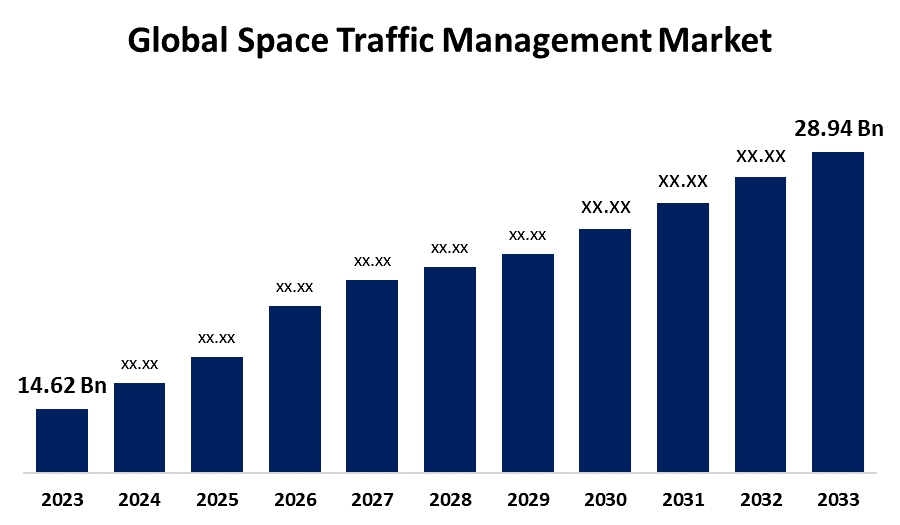Global Space Traffic Management Market Size, Share, and COVID-19 Impact Analysis, By Traffic Type (Launch Vehicles, Satellite and Others), By Orbit Type (Geostationary Orbit (GEO), Low-Earth Orbit (LEO) and Medium Earth Orbit (MEO)), By Application (Space Situational Awareness, Space Debris Remediation, Space Orbit Management, Launch Vehicle Operations, and Others), By End User (Civil & Government, Commercial, and Military), and By Region (North America, Europe, Asia-Pacific, Latin America, Middle East, and Africa), Analysis and Forecast 2023 - 2033
Industry: Aerospace & DefenseGlobal Space Traffic Management Market Insights Forecasts to 2033
- The Global Space Traffic Management Market Size was Valued at USD 14.62 Billion in 2023
- The Market Size is Growing at a CAGR of 7.07% from 2023 to 2033
- The Worldwide Space Traffic Management Market Size is Expected to Reach USD 28.94 Billion by 2033
- Asia Pacific is Expected to Grow the fastest during the forecast period.

Get more details on this report -
The Global Space Traffic Management Market Size is Anticipated to Exceed USD 28.94 Billion by 2033, Growing at a CAGR of 7.07% from 2023 to 2033.
Market Overview
Monitoring the motion of spacecraft and other objects to prevent collisions and maintain the security of people and property is known as space traffic management. Space traffic management consists of the procedures, frameworks, and regulations used to carry out operations in space safely, sustainably, and securely. One of the most significant developments in space politics at the time is space traffic management (STM). It is stated that space is "contested, congested, and competitive." The requirement for increased safety and efficiency in the operation of satellites and other space-based assets is driving the growing demand for space traffic management. Due to automated systems can be quite beneficial in each of these fields, it is anticipated that their use will grow in the forecast period. Increased spending on satellite launches and space exploration driving the space traffic management market.
Report Coverage
This research report categorizes the space traffic management market based on various segments and regions forecasts revenue growth and analyzes trends in each submarket. The report analyses the key growth drivers, opportunities, and challenges influencing the space traffic management market. Recent market developments and competitive strategies such as expansion, type launch, development, partnership, merger, and acquisition have been included to draw the competitive landscape in the market. The report strategically identifies and profiles the key market players and analyses their core competencies in each sub-segment of the space traffic management market.
Space Traffic Management Market Report Coverage
| Report Coverage | Details |
|---|---|
| Base Year: | 2023 |
| Market Size in 2023: | USD 14.62 Billion |
| Forecast Period: | 2023-2033 |
| Forecast Period CAGR 2023-2033 : | 7.07% |
| 2033 Value Projection: | USD 28.94 Billion |
| Historical Data for: | 2019-2022 |
| No. of Pages: | 204 |
| Tables, Charts & Figures: | 110 |
| Segments covered: | By Traffic Type, By Orbit Type, By Application, By End User |
| Companies covered:: | Space Machines Company, Ananth Technologies, Digantara, Neuraspace, Lockheed Martin, Saab AB,, Northrop Grumman, Raytheon Technologies, BAE Systems plc, Thales Group, L3Harris Technologies, Inc., Airbus Group, Kayhan Space, and Boeing Company and Others. |
| Pitfalls & Challenges: | Covid-19 Empact, Challenges, Growth, Analysis. |
Get more details on this report -
Driving Factors
The market for space traffic management is being driven by increased space congestion caused by an increase in space launches and spacecraft as well as by leftover space debris. Moreover, for the space traffic management market, precise tracking and traffic control of space debris are essential. An international coordinate body must create standards and directives for national and subnational space operations to improve the sustainability of the space environment. The growing number of satellites and spacecraft sent into orbit requires efficient space traffic management (STM) solutions to reduce the risk of collisions and space debris, which is one of the major drivers driving the space traffic management (STM) market.
Restraining Factors
The growth of the market for space traffic management is anticipated to be restricted by the 5–10% increase in satellite operating costs that come with improvements to their components and movements.
Market Segmentation
The space traffic management market share is classified into traffic type, orbit type, application, and end user.
- The satellite segment is estimated to hold the largest market revenue share through the projected period.
Based on the traffic type, the space traffic management market is classified into launch vehicles, satellite, and others. Among these, the satellite segment is estimated to hold the largest market revenue share through the projected period. The Atlantic Council, 25,000 additional satellites representing more than 4,800 operational satellites from more than 40 nations are expected to enter Earth's orbit. As release prices come down and more satellites reach Earth's orbit, these kinds of collisions will develop more frequently.
- The low-earth orbit (LEO) segment is estimated to hold the largest market revenue share through the projected period.
Based on its orbit type, the space traffic management market is classified into geostationary orbit (GEO), low-earth orbit (LEO), and medium earth orbit (MEO). Among these, the low-earth orbit (LEO) segment is estimated to hold the largest market revenue share through the projected period. The number of operational on-orbit spacecraft and object density in low-Earth orbit (LEO) have significantly increased due to the deployment of very large satellite constellations and the proliferation of tiny satellites.
- The space situational awareness segment is anticipated to hold the largest market share through the forecast period.
Based on the application, the space traffic management market is divided into space situational awareness, space debris remediation, space orbit management, launch vehicle operations, and others. Among these, the space situational awareness segment is anticipated to hold the largest market share through the forecast period. The use of space situational awareness (SSA) can assist operators receive information quickly. The more satellites in orbit, the greater the chance of a space accident that can lead to catastrophic space disasters and financial loss.
- The commercial segment is anticipated to hold the largest market share through the forecast period.
Based on the end user, the space traffic management market is divided into civil & government, commercial, and military. Among these, the commercial segment is anticipated to hold the largest market share through the forecast period. Most of the commercial end users are private companies that design, build, and launch advanced rockets and spacecraft.
Regional Segment Analysis of the Space Traffic Management Market
- North America (U.S., Canada, Mexico)
- Europe (Germany, France, U.K., Italy, Spain, Rest of Europe)
- Asia-Pacific (China, Japan, India, Rest of APAC)
- South America (Brazil and the Rest of South America)
- The Middle East and Africa (UAE, South Africa, Rest of MEA)
North America is anticipated to hold the largest share of the space traffic management market over the predicted timeframe.

Get more details on this report -
North America is anticipated to hold the largest share of the space traffic management market over the predicted timeframe. The space traffic management market in North America is composed of the US, Canada, and Mexico, which together have a population of about 504 Billion. This region, which contributes 27.5% of the world's GDP and is well-known for its high-income economies, sophisticated infrastructure, and strong industrial base, is an important player in the global economy. The United States of America is the country with the highest space budget worldwide, having committed over US$ 54.6 billion to space initiatives.
Asia Pacific is expected to grow at the fastest CAGR growth of the space traffic management market during the forecast period. Asia Pacific region China spends a lot of money on space activities. China will also strengthen space traffic control and upgrade its debris monitoring system. China makes a large contribution to the Asia-Pacific Space Traffic Management market as a prominent actor in space exploration. Robust management systems are required due to the nation's ambitious space program and rising number of satellite launches.
Europe is anticipated to hold a significant share of the space traffic management market over the predicted timeframe. The market for space traffic management in Europe is expanding rapidly, with Germany, France, and the UK leading the way owing to high customer demand. With the increased expenditures and technical breakthroughs, Italy and Spain also made substantial contributions. Benelux and Scandinavian nations are growing steadily, with a focus on innovation and sustainability.
Competitive Analysis:
The report offers the appropriate analysis of the key organizations/companies involved within the space traffic management market along with a comparative evaluation primarily based on their type of offering, business overviews, geographic presence, enterprise strategies, segment market share, and SWOT analysis. The report also provides an elaborative analysis focusing on the current news and developments of the companies, which includes type development, innovations, joint ventures, partnerships, mergers & acquisitions, strategic alliances, and others. This allows for the evaluation of the overall competition within the market.
List of Key Companies
- Space Machines Company
- Ananth Technologies
- Digantara
- Neuraspace
- Lockheed Martin
- Saab AB,
- Northrop Grumman
- Raytheon Technologies
- BAE Systems plc
- Thales Group
- L3Harris Technologies, Inc.
- Airbus Group
- Kayhan Space
- Boeing Company
- Others
Key Target Audience
- Market Players
- Investors
- End-users
- Government Authorities
- Consulting And Research Firm
- Venture capitalists
- Value-Added Resellers (VARs)
Recent Developments
- In September 2024, To completely transform space operations and traffic management, Space Machines Company has partnerships with Ananth Technologies and Digantara. The Space MAITRI mission and the 2026 launch of their second Optimus satellite, which will be a significant advancement in India-Australia space ties, depend on this cooperation.
- In April 2024, Space traffic management (STM) leader Neuraspace, a European-born company, launched two new tiers to its end-to-end STM platform the subscription-based PRO tier and SYNC, which is offered for free. These two levels offer a new real-time and cooperative satellite operator interchange and are software-as-a-service (SaaS) based.
Market Segment
This study forecasts revenue at global, regional, and country levels from 2023 to 2033. Spherical Insights has segmented the space traffic management market based on the below-mentioned segments:
Global Space Traffic Management Market, By Traffic Type
- Launch Vehicles
- Satellites
- Others
Global Space Traffic Management Market, By Orbit Type
- Geostationary orbit (GEO)
- Low Earth orbit (LEO)
- Medium Earth orbit (MEO)
Global Space Traffic Management Market, By Application
- Space Situational Awareness
- Space Debris Remediation
- Space Orbit Management
- Launch Vehicle Operations
- Others
Global Space Traffic Management Market, By End User
- Civil and Government
- Commercial
- Military
Global Space Traffic Management Market, By Regional Analysis
- North America
- US
- Canada
- Mexico
- Europe
- Germany
- UK
- France
- Italy
- Spain
- Russia
- Rest of Europe
- Asia Pacific
- China
- Japan
- India
- South Korea
- Australia
- Rest of Asia Pacific
- South America
- Brazil
- Argentina
- Rest of South America
- Middle East & Africa
- UAE
- Saudi Arabia
- Qatar
- South Africa
- Rest of the Middle East & Africa
Frequently Asked Questions (FAQ)
-
1. What is the CAGR of the space traffic management market over the forecast period?The space traffic management market is projected to expand at a CAGR of 7.07% during the forecast period.
-
2. What is the market size of the space traffic management market?The Global Space Traffic Management Market Size is Expected to Grow from USD 14.62 Billion in 2023 to USD 28.94 Billion by 2033, at a CAGR of 7.07% during the forecast period 2023-2033.
-
3. Which region holds the largest share of the space traffic management market?North America is anticipated to hold the largest share of the space traffic management market over the predicted timeframe.
Need help to buy this report?